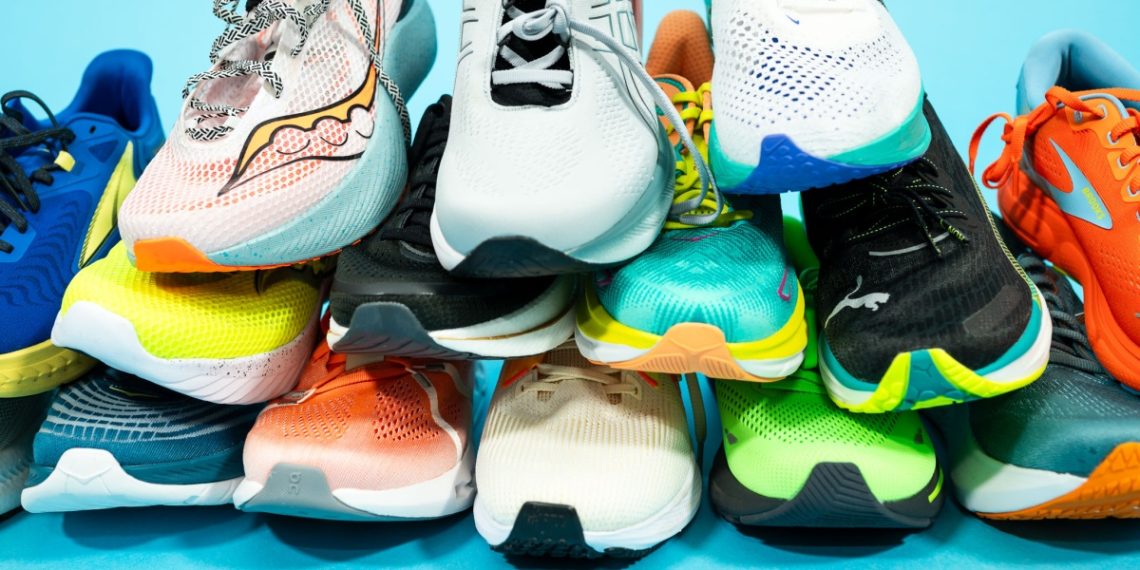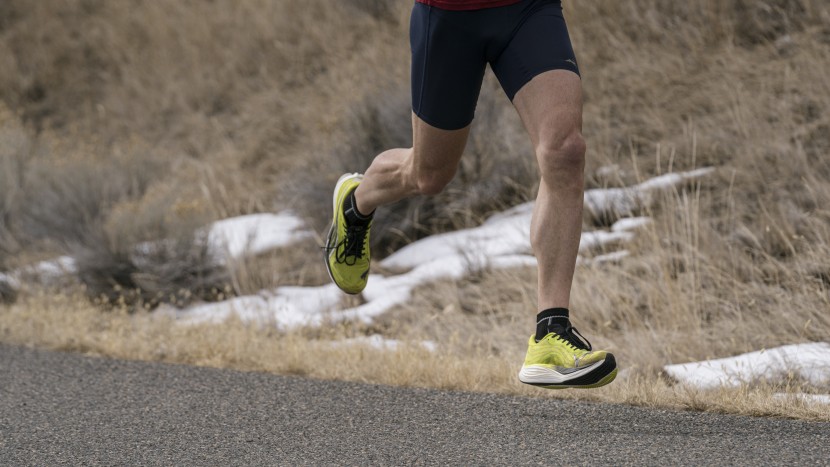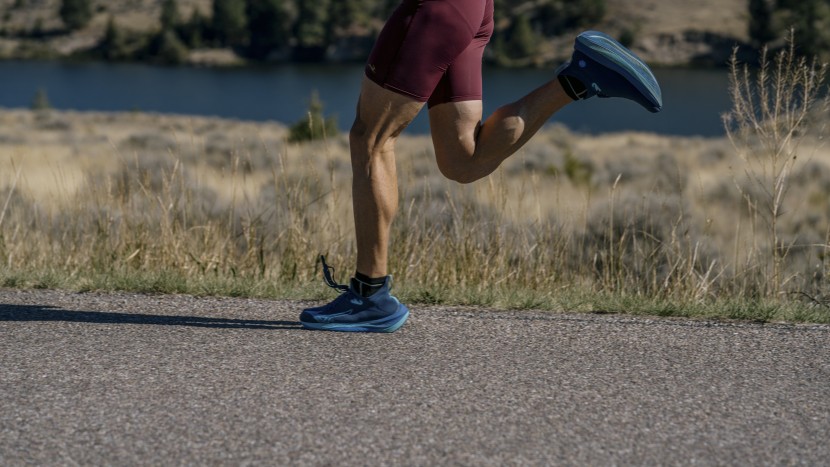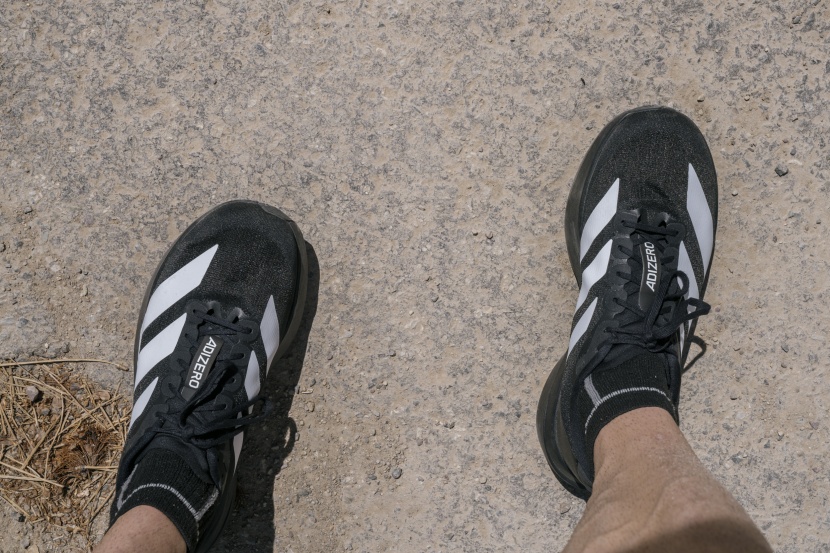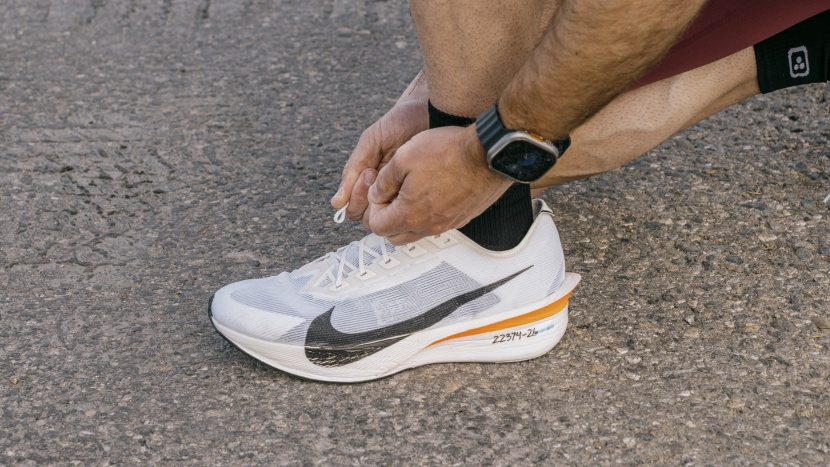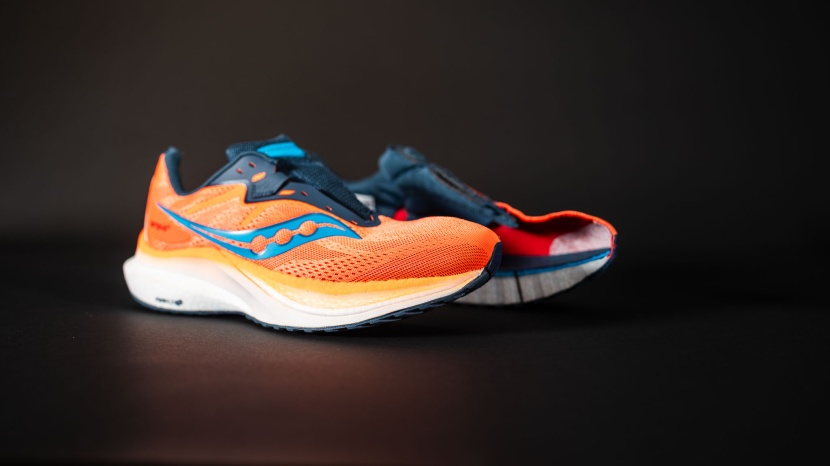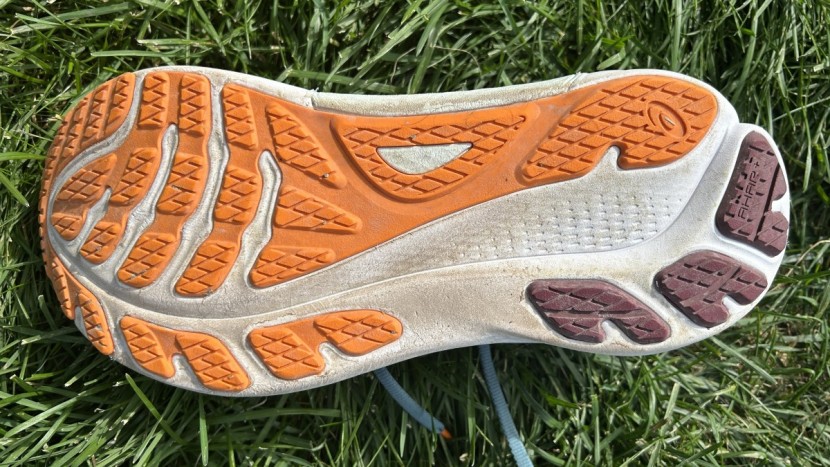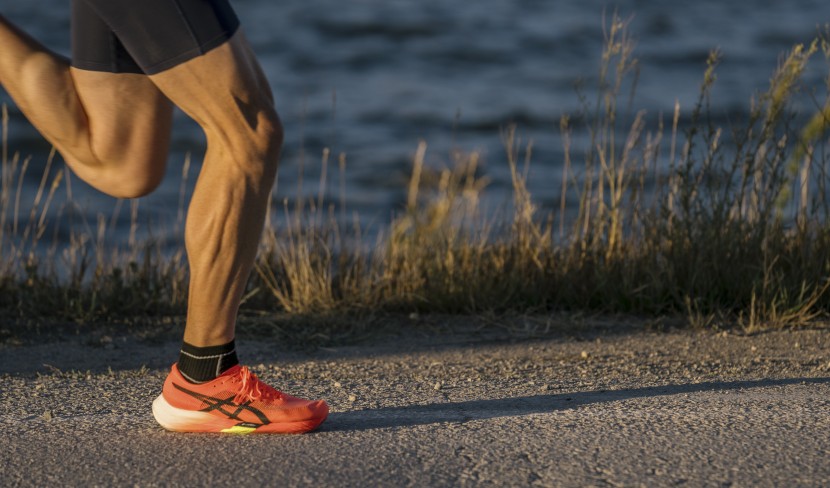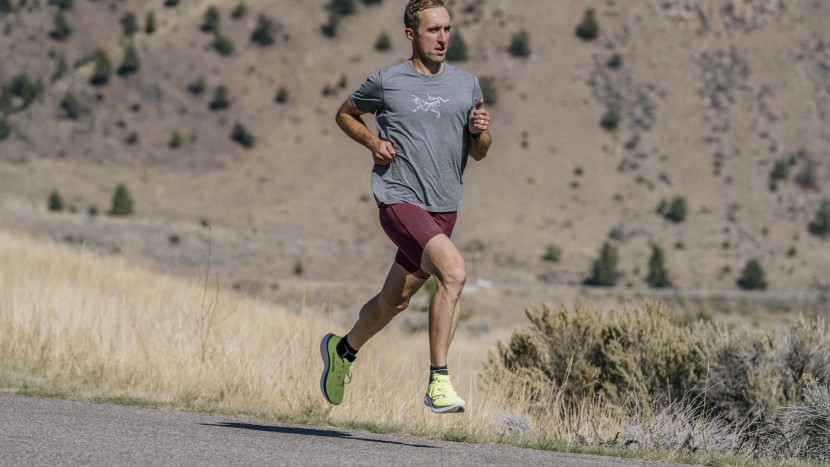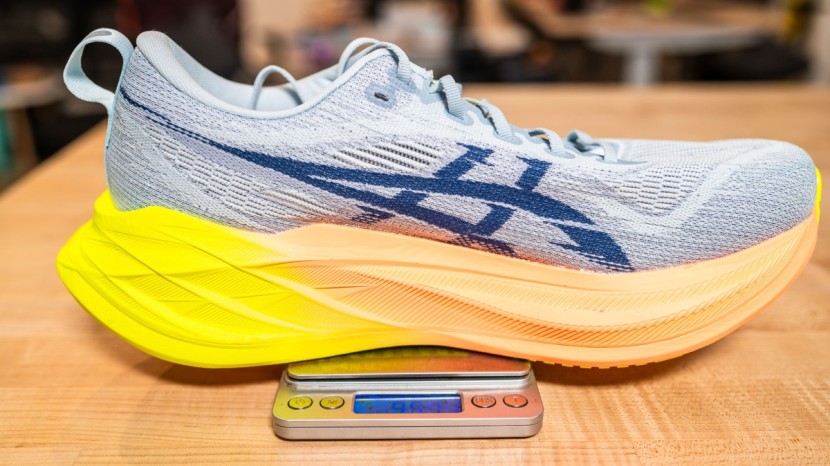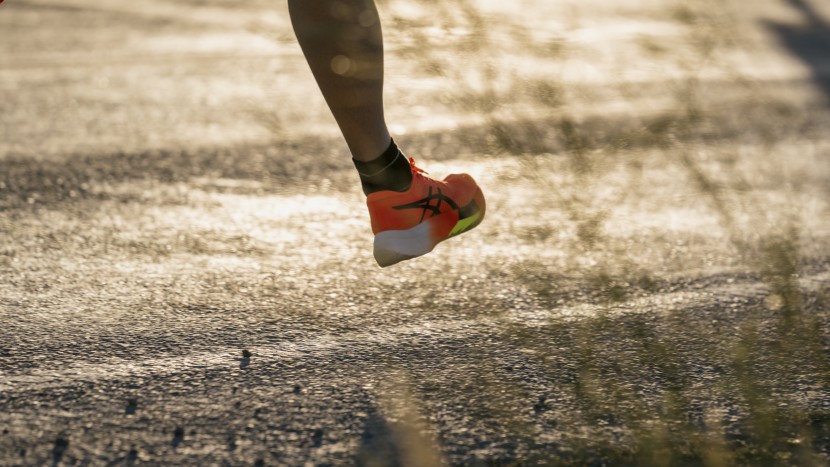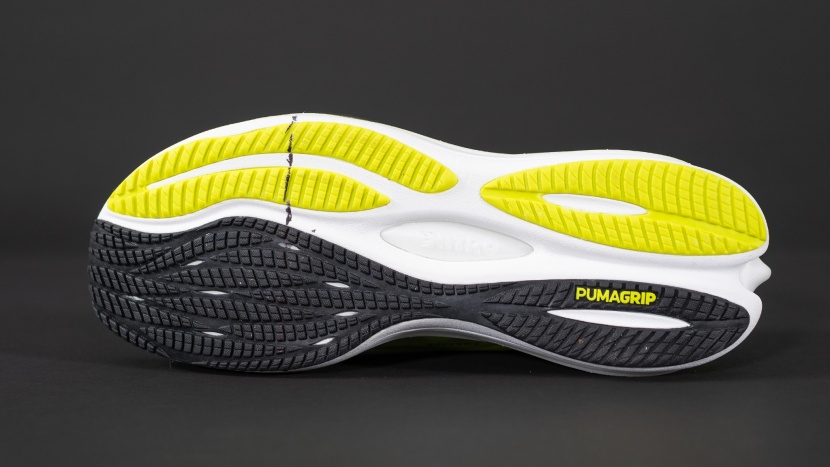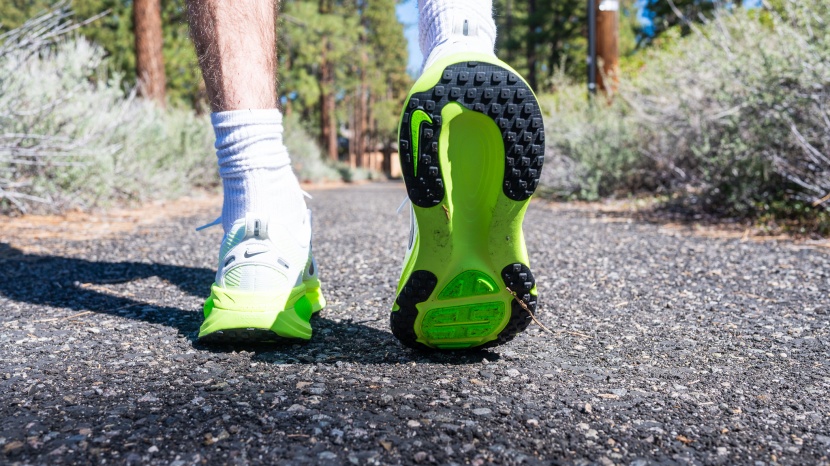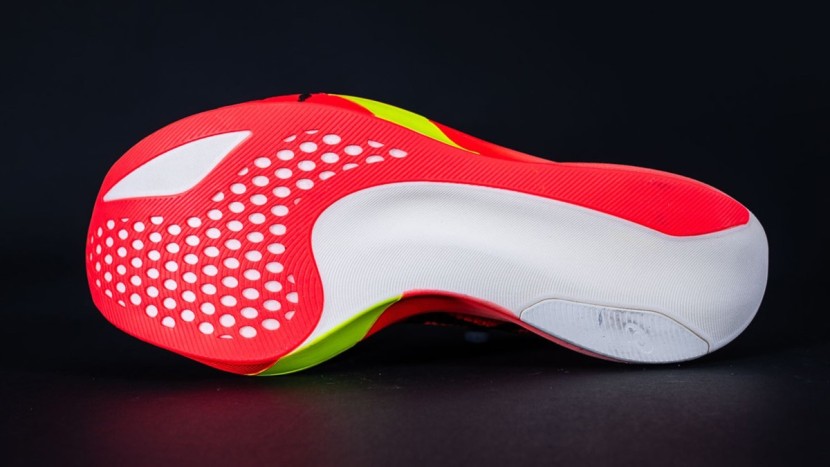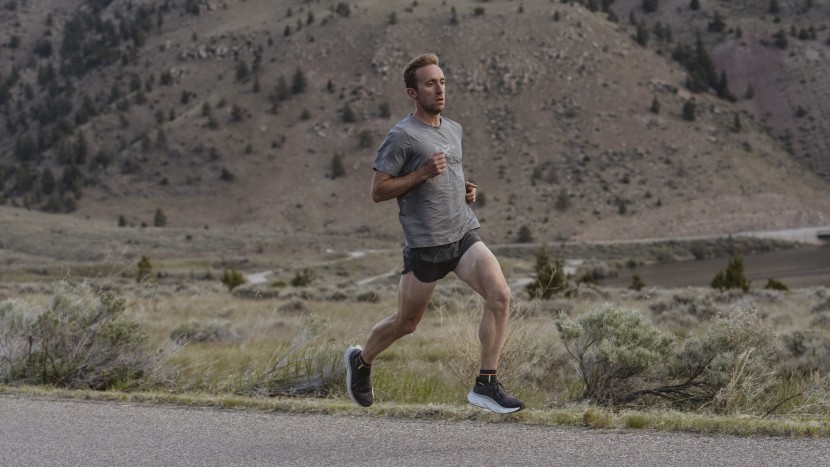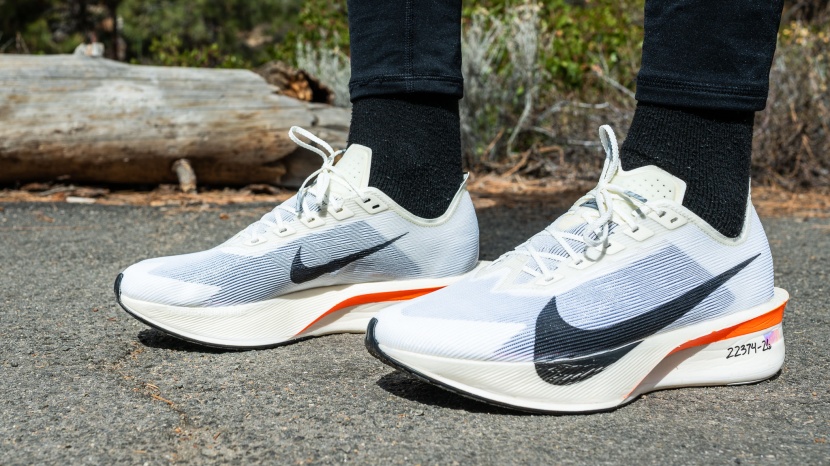Our Picks of Men’s Running Shoes
Best Overall
Asics Novablast 5
PROS
Soft and bouncy foam
Pace versatility
Smooth ride
Premium comfort
The Asics Novablast 5 is our go-to all-around running shoe. For daily mileage, it’s comfortable, plush, and enjoyable. For faster running, the resilient midsole has bouncy energy return, and the rocker geometry helps keep things rolling. Lead tester and USA Track & Field certified coach Nathaniel Bailey gushes, “Heel-strikers will love the smooth rolling feeling, and as a mid-foot striker, I love the trampoline-like forefoot on long runs. This is one of the most universally comfortable shoes I’ve ever run in.”
SPECIFICATIONS
| Measured Weight | 269 g | 9.50 oz |
|---|---|
| Best Use | Versatile for variable paces |
| Measured Heel-to-Toe Drop | 5 mm |
This version of the Novablast is a little more optimized for daily comfort than the previous model, happiest at easy-to-moderate paces, but we still have enjoyed small doses of 5K-paced training in this shoe. The lightweight and breathable upper of the Novablast 5 is comfortable and well-designed to provide a good fit for many runners. The versatility in fit, ride, and performance is what makes this such an easy recommendation for many road runners. If you want a fun and reliable training partner at a great price, you’ll be hard-pressed to find a better option.
Read more: Asics Novablast 5 review
The Novablast 5 is our favorite daily trainer, with attributes that make it approachable and ideal for a wide variety of runners and preferences.
Credit: Nathaniel Bailey
Most Comfortable
New Balance Fresh Foam X More v5
PROS
Plush ride
Smooth transitions
Premium feel
CONS
Chunky
Short upper fit
The New Balance Fresh Foam X More v5 gives you a massive chunk of soft and smooth foam to run on. It’s one of the most comfortable cruisers in our lineup thanks to the excellent underfoot cushioning, smooth geometry, and comfortable upper materials. Lead tester Nathaniel notes, “I love how soft this feels underfoot — it seriously saves my legs and joints.” This is our go-to choice for recovery days when we want to feel insulated from the road.
SPECIFICATIONS
| Measured Weight | 346 g | 12.19 oz |
|---|---|
| Best Use | Relaxed running |
| Measured Heel-to-Toe Drop | 7 mm |
Thanks to the excellent rocker geometry, the More v5 rolls along smoothly, making it enjoyable for long runs. Thanks to a wide base and excellent sidewall structure, it’s also one of the most stable max-cushioned shoes we’ve tested. That said, this is the heaviest shoe in our lineup — though we think it’s worth its weight. If you’re after a plush running experience to log miles at low paces, it’s hard to beat the More v5.
Read more: New Balance Fresh Foam X More v5 review
For true comfort on the pavement, this shoe is well worth its weight.
Credit: Natalie Kafader
Most Stable
Saucony Tempus 2
PROS
Excellent stability and support
Responsive ride
Good traction
CONS
Midfoot may feel firm to some runners
Fit runs narrower
Unlike traditional stability shoes, the Saucony Tempus 2 is actually fun to run in. Pairing a firmer frame with an energetic midsole results in a shoe that provides significant amounts of support without compromising the ability to change pace. This shoe feels best at comfortable to moderate paces, and we love it most on long runs, where the combination of lower weight, excellent cushioning, and sneaky support left us feeling great two hours in. Track coach and lead tester Nathaniel Bailey remarked, “The Tempus reset my expectations for stability shoes. It supports my feet and keeps me solidly locked in place without compromising all the fun in my runs.”
SPECIFICATIONS
| Measured Weight | 258 g | 9.11 oz |
|---|---|
| Best Use | Versatile for variable paces |
| Measured Heel-to-Toe Drop | 10 mm |
We don’t have a lot of things to complain about with the Tempus 2. The fit runs a little narrow, but we don’t think it will be too narrow for most runners. It’s also worth noting that the midfoot of this shoe is firm but not uncomfortable. Overall, this is a top-notch stability trainer that we think will have wide appeal. It’s actually so good that our lead tester — a lifelong neutral runner — has added the Tempus to his rotation of personal running shoes.
Read more: Saucony Tempus 2 review
The Tempus 2 is the most fun stability shoe we’ve tested, and it’s stuck around in our personal rotations as well.
Credit: Nathaniel Bailey
MYTH-BUSTING: Who Needs a Stability Shoe?
The vast majority of runners don’t need a stability shoe, regardless of whether they pronate or supinate or are “neutral” runners. In fact, most current research suggests that choosing a shoe based on your movement patterns is ineffective at preventing injuries, with very limited exceptions. The best predictor of whether a shoe will work for you is how it feels when you try it on — if it feels great, awesome. If not, move on.
Best Under $100
New Balance FuelCell Propel v5
PROS
Comfortable on long runs
Responsive at faster paces
Well-made upper
CONS
Feels heavy
Plate is less comfortable
If you’re hunting for a good deal and a comfortable shoe, the New Balance FuelCell Propel v5 is your best bet. These shoes are ideal for the easy-to-mid-paced runner who doesn’t care too much about pushing the pace. Much of what we love about these shoes is their underfoot comfort — they performed best on casual runs and hot days. Nathaniel Bailey, our lead tester, said, “These shoes were very comfortable during even my long runs, with strategic cushioning and a well-designed upper.”
SPECIFICATIONS
| Measured Weight | 298 g | 10.52 oz |
|---|---|
| Best Use | Relaxed running |
| Measured Heel-to-Toe Drop | 7 mm |
The FuelCell Propel v5 isn’t without its limitations. It is one of the heavier shoes in our lineup, and the plastic midsole plate that helps provide some stiffness also makes this shoe a bit uncomfortable on uneven surfaces. It’s firm yet well-cushioned, and reasonably versatile across varied moderate paces and efforts. For most casual runners, this shoe is a worthy contender — especially at its current discounted rate of up to 45% off of retail value.
Read more: New Balance FuelCell Propel v5 review
The FuelCell Propel v5 is well-cushioned and comfortable for long runs.
Credit: Natalie Kafader
Best for Beginners
Saucony Ride 18
PROS
Reliable and predictable ride
Great cushioning
Comfortable upper
Great value
CONS
Traction is mediocre
Not the best for fast running
In just about every case, new runners are best served by a simple and reliable daily trainer with solid cushioning, a relatively natural geometry, and a stable-neutral ride that also works well for walking. The Saucony Ride 18 checks all of those boxes. It’s not just a shoe for beginners, but it provides great value and a set of features that we think new runners will enjoy and benefit from. The midsole foam does a great job of insulating your legs from harsh landings, with our lead tester commenting, “I really enjoy this shoe for my easy mileage. It’s soft without feeling mushy, and the upper feels great on days when I just want comfort.”
SPECIFICATIONS
| Measured Weight | 287 g | 10.13 oz |
|---|---|
| Best Use | Relaxed running |
| Measured Heel-to-Toe Drop | 6 mm |
If you’re a new runner, you might be wondering why we recommend this option over something like the excellent Novablast 5. There are two reasons. First, the geometry is more natural. The Ride doesn’t have an extremely noticeable rocker or a trampoline effect, letting your body more easily find its natural movement patterns. Second, it has a lower stack height, which feels a little more planted and stable for folks just starting out. This also means they feel significantly better while walking between bouts of running. Overall, the Ride is a great and durable introductory shoe, a consistent training companion, and comes at a reasonable price point.
Read more: Saucony Ride 18 review
The Ride makes a great daily mileage shoe, and it’s featureset make it a good option for new runners.
Credit: Nathaniel Bailey
Best for Durable Cushioning
Nike Vomero 18
PROS
Absorptive cushioning
Very smooth rocker
Great whole-foot comfort
CONS
Heavy and a bit chunky
Best at low speeds
The last thing anyone wants is a pair of shoes that squish flat, leaving your joints to soak up all the shock of your strides. The Nike Vomero 18 has got your back. This affordable shoe has a thick stack that’s exceptionally comfortable, made of a pairing of two of Nike’s top midsole foams that provide resiliency and bounce over long miles under heavier footfalls. Track coach Nathaniel Bailey added this shoe to his personal rotation after testing, noting, “The Vomero feels planted and nimble and runs oh-so-smoothly. It’s soft but not pillowy and still reasonably energetic.”
SPECIFICATIONS
| Measured Weight | 329 g | 11.62 oz |
|---|---|
| Best Use | Relaxed running |
| Measured Heel-to-Toe Drop | 11 mm |
With a more moderate forefoot rocker than most and a slightly above-average heel-toe drop, the Vomero rolls along pleasantly and easily. It has a super comfortable and breathable upper that easily accommodates feet of varying volumes. Though it’s a tad tall and chunky, this combination of soft, resilient foam on top, supported by firm, structured foam underneath, makes this added weight well worth it. This is the best shoe we’ve tested for maintaining cushioning, with a durable build that keeps up with you.
Read more: Nike Vomero 18 review
The Vomero has made its way into Nathaniel’s regular rotation (outside of testing) thanks to its comfortable upper and plush ride that doesn’t feel clunky.
Credit: Nathaniel Bailey
Best for Race Training
Adidas Adizero Evo SL
PROS
Best-in-class versatility
Well-cushioned
Fun ride, especially at faster paces
Incredible value
If your typical week of running involves regular pace changes or training for a race, then the Adidas Adizero Evo SL is perfect for you. Adidas’s responsive and cushy foam in the midsole pairs with a smooth, early midfoot rocker and a lightweight, breathable upper. The result is an incredibly versatile shoe that’s comfortable on easy runs and engaging when we push the pace. Our lead tester and track coach, Nathaniel, said, “This has quickly become my favorite shoe — not just in our lineup, but of all time.”
SPECIFICATIONS
| Measured Weight | 247 g | 8.73 oz |
|---|---|
| Best Use | Versatile for variable paces |
| Measured Heel-to-Toe Drop | 9 mm |
While it doesn’t have quite as much top-end speed as some plated daily trainers and true race shoes, the Adizero Evo SL is far more comfortable (and fun) at relaxed paces. As a result, we reach for it regularly. It’s become a favorite for progression runs that start slow and finish fast, as well as big, long runs with chunks of faster paces. If you’re training for a race and only want to have one shoe, this is the one we recommend. And if you have a rotation, it works great as an option for workouts at moderate paces, hard long runs, or faster easy days.
Read more: Adidas Adizero Evo SL review
The Evo SL is simple, yet extremely versatile. It’s a unique shoe that stands out for it’s performance and value.
Credit: Nathaniel Bailey
Best for Race Day
Asics Metaspeed Sky Paris
PROS
Extremely fast
High cushioning and responsiveness
Insanely light
CONS
Struggles on loose surfaces
Narrow fit through the midfoot is less accommodating
The Asics Metaspeed Sky Paris has an incredibly low weight, high energy return midsole foam, and an aggressive-performing yet natural-feeling geometry. While other popular racing shoes have a learning curve to getting the most propulsion, the Metaspeed Sky Paris does not. Track coach and lead tester Nathaniel Bailey pointed out, “This combo of a natural rocker and a stiff upper makes it easy for pretty much anyone to race in the Metaspeed.”
SPECIFICATIONS
| Measured Weight | 194 g | 6.85 oz |
|---|---|
| Best Use | Ready to race |
| Measured Heel-to-Toe Drop | 6 mm |
Sacrificing weight for race day does leave the Metaspeed light on traction. It struggles to bite on wet tracks and gravelly corners — and, like most racing shoes, has very little lateral stability. Yet, for most road races, this ultralight shoe is our favorite choice from a road mile to a full marathon. While most other racing shoes only work well at high speeds, this pair works with diverse strides and is comfortable (for a race shoe).
Read more: Asics Metaspeed Sky Paris review
The Metaspeed Sky Paris is now the shoe we grab for almost any race on pavement.
Credit: Nathaniel Bailey
Compare Product Specifications
| Specifications | Asics Novablast 5 | New Balance Fresh Foam X More v5 | Asics Gel-Kayano 31 | Saucony Tempus 2 | Adidas Adizero Evo SL | Saucony Endorphin Speed 4 | Puma Velocity Nitro 3 | Saucony Ride 18 | Nike Vomero 18 | Brooks Hyperion Max 2 | Brooks Adrenaline GTS 24 | Adidas Adizero SL2 | New Balance FuelCell Propel v5 | Asics Metaspeed Sky Paris | Nike Vaporfly 4 | Hoka Mach 6 | Puma Deviate Nitro 3 |
|---|---|---|---|---|---|---|---|---|---|---|---|---|---|---|---|---|---|
| Awards | Best Overall |
Most Comfortable |
Most Stable |
Best for Race Training |
Best for Beginners |
Best for Durable Cushioning |
Best Under $100 |
Best for Race Day |
|||||||||
| Measured Weight | 269 g | 9.50 oz | 346 g | 12.19 oz | 331 g | 11.68 oz | 258 g | 9.11 oz | 247 g | 8.73 oz | 256 g | 9.03 oz | 285 g | 10.07 oz | 287 g | 10.13 oz | 329 g | 11.62 oz | 274 g | 9.68 oz | 303 g | 10.70 oz | 265 g | 9.36 oz | 298 g | 10.52 oz | 194 g | 6.85 oz | 183 g | 6.45 oz | 246 g | 8.69 oz | 296 g | 10.43 oz |
| Best Use | Versatile for variable paces | Relaxed running | Relaxed running | Versatile for variable paces | Versatile for variable paces | Versatile for variable paces | Versatile for variable paces | Relaxed running | Relaxed running | Versatile for variable paces | Relaxed running | Versatile for variable paces | Relaxed running | Ready to race | Ready to race | Versatile for variable paces | Versatile for variable paces |
| Measured Heel-to-Toe Drop | 5 mm | 7 mm | 12 mm | 10 mm | 9 mm | 11 mm | 11 mm | 6 mm | 11 mm | 8 mm | 13 mm | 9 mm | 7 mm | 6 mm | 9 mm | 8 mm | 12 mm |
| Measured Heel Stack Height | 41 mm | 42 mm | 42 mm | 38 mm | 39 mm | 38 mm | 38 mm | 34 mm | 41 mm | 37 mm | 39 mm | 38 mm | 38 mm | 39 mm | 36 mm | 38 mm | 41 mm |
| Midsole | FF Blast Max | Fresh Foam X | FF Blast + Eco | PWRRUN/PWRRUN PB | Lightstrike Pro | PWRRUN PB | Profoam | PWRRUN+ | ZooomX, ReactX | DNA Flash v2 | DNA Loft v3 | Lightstrike Pro, Lightstrike | FuelCell | FF Turbo Plus | ZoomX | Supercritical EVA | NITROFOAM |
| Plate Type | None | None | None | None | None | Nylon | None | None | None | Full-length plastic | None | None | Full-length plastic | Carbon | Carbon | None | Carbon |
| Rocker Angle | 25.0 deg | 26.5 deg | 21.5 deg | 25.0 deg | 23.5 deg | 25.0 deg | 18.0 deg | 25.0 deg | 21.0 deg | 25.0 deg | 25.0 deg | 21.0 deg | 19.0 deg | 24.5 deg | 23.5 deg | 21.0 deg | 26.5 deg |
| Rocker Apex Location | 56.0% | 59.0% | 69.6% | 62.8% | 52.0% | 67.7% | 66.7% | 60.0% | 56.0% | 62.5% | 58.3% | 53.3% | 68.3% | 68.3% | 57.9% | 62.8% | 62.8% |
| Upper | Engineered jacquard mesh | Engineered mesh | Engineered mesh | Engineered mesh | Engineered mesh | Engineered mesh/knit | Engineered knit | Engineered mesh | Engineered mesh | Engineered mesh | Engineered mesh | Engineered mesh | Engineered mesh | Motionwrap 2.0 | Engineered mesh | Creel jaqquard | Engineered mesh |
| Outsole | AHAR LO | Rubber | Hybrid AsicsGrip | Rubber | Continental rubber | Rubber | PumaGrip | Rubber | Rubber | Rubber | Rubber | Rubber | Rubber | AsicsGrip rubber | Rubber | Rubber | Rubber |
| Heel Tab Type | Finger loop | None | Finger loop | Finger loop | None | None | None | None | Finger loop | Extended heel pull | None | Pull tab | None | None | Pull tab | Extended heel pull | None |
| Style | Daily Trainer | Max-Cushion | Daily Trainer | Stability | Daily Trainer | Daily Trainer | Daily Trainer | Daily Trainer | Max-Cushion | Daily Trainer | Stability | Daily Trainer | Daily Trainer | Racing | Racing | Daily Trainer | Daily Trainer |
| Sizes Available | 6-15 US, regular & wide | 7-16 US, regular, wide & extra wide | 6-16 US, regular, wide & extra wide | 7-15 US, regular | 6.5-16 US, regular | 7-15 US, regular | 7 – 14 US, regular | 7-15 US, regular | 6-18 US, regular | 7-15 US, regular | 7 – 15 US, narrow, regular, wide & extra wide | 4-19 US, regular & wide | 7-18 US, regular & wide | 3.5-13 US, regular | 6-16.5 US, regular | 7-14 US, regular & wide | 4-19 US, regular |
In addition to running all these shoes through their paces, we sent a second pair to our testing facility to get precise measurements on things like stack height, compression stiffness, and rocker angle. Credit: Natalie Kafader
How We Tested
Our running experts have tested hundreds of pairs of running shoes since 2011, purchasing every pair ourselves. Each shoe is put through a rigorous set of runs, including a standardized 6-mile test loop that contains hardpacked dirt, loose gravel, asphalt, concrete, and grass surfaces. Every single pair is tested over at least 50 miles, with many closer to 100. In the lab, we cut every pair in half, taking copious measurements and examining construction materials.
We then score each shoe on six weighted metrics:
- Cushioning (35% of overall score weighting)
- Upper Comfort (25% weighting)
- Stability (20% weighting)
- Responsiveness (10% weighting)
There’s no industry standard for measuring heel-to-toe drop, so each company chooses its own way to calculate this — with no requirement to divulge their methods. To have standardized and comparable data, we cut every shoe in half and measure all of these things ourselves based on the World Athletics stack height standards used to regulate professional racing.
Why Trust GearLab
A team of experts and professionals helps to shape this review. Starting with lead tester Nathaniel Bailey, who has always loved running. He competed in track and cross country at the middle school, high school, and collegiate levels. Now, he continues to chase “fast” times on the roads. Nathaniel is a USATF-certified coach who works with post-collegiate and high school runners, sharing his passion for the sport and continuing to develop his knowledge of endurance sports and physiology.
Professional running biomechanics consultant, Carrie Vickers, helped to inform and design our testing methods and provided additional guidance for our advice on how to choose the best shoes for you. Carrie is an accomplished national-class runner, having ranked in numerous Olympic, US National, and World Championship competitions for steeplechase. Though it has since been broken, she once held the world record for the 2000-meter steeplechase. Carrie also helped to design our jogging stroller review.
Our laboratory team includes manufacturing engineer, Sentry Kelly, taking apart and meticulously measuring every pair of shoes in a standardized and comparable way.
We put each pair of shoes through standardized testing to provide a fair assessment.
Credit: Nathaniel Bailey
Analysis and Test Results
Running shoes are often designed with a specific purpose. Max-cushioned shoes are designed to eat up mileage while providing excellent comfort. Race shoes are designed for speed at the expense of everything else. It doesn’t make sense to buy a race shoe for your easy runs, so we’ll break down each performance metric into three categories: Daily Trainers, Max-Cushioned Trainers, and Race Shoes.
Between our article on how to choose running shoes and our detailed reviews, we believe you’ll find the best running shoe for your needs and budget here. Read on to see how each contender performs in the different test metrics.
What’s the Best Value?
Value is a huge consideration when you’re logging miles. Some runners want to get the most mileage per dollar they can, while others care more about performance than durability. The Asics Novablast 5 is our favorite model for value, blending top-tier performance, superb comfort, and exceptional versatility at a reasonable price. The Adidas Adizero Evo SL is another standout contender with incredible performance at a surprisingly decent price.
Budget Shoes for Beginners
Burning through running shoes can get expensive — we have firsthand experience with that. Shopping for a good deal is always advisable, but we think that super low-budget, entry-level shoes are almost never worth the money. Instead of purchasing an entry-level trainer like that, we highly recommend shopping around for previous models of our award-winners.
Past versions of shoes are always a great value, though they tend to sell out quickly after the new model is released. Leading up to new version drops, shoes also tend to go on sale. We try to keep up with these sales to offer you shoes we can solidly recommend the performance of, at outstanding — but often temporary — prices. The New Balance FuelCell Propel v5 is one such example, which can currently be found for slightly over half of its retail value.
What shoe holds the best for you depends on where you run, how far you run, your specific stride, your anatomy, and your unique running goals.
Cushioning
When we’re assessing this category, we’re most interested in how a shoe feels underfoot while running.
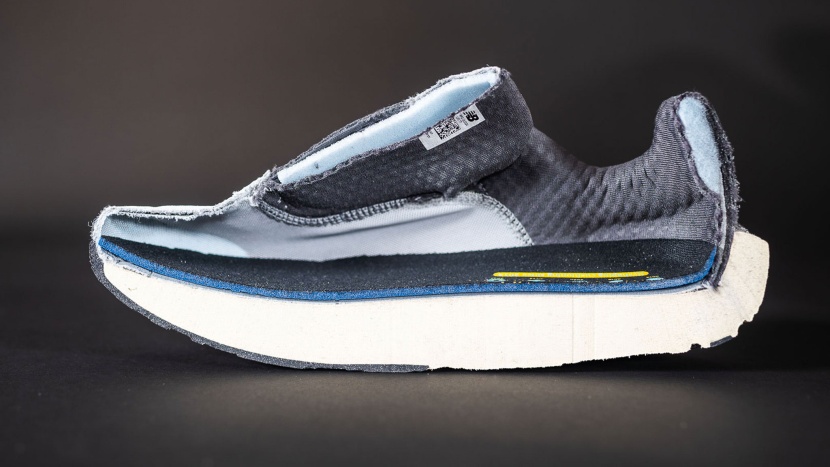
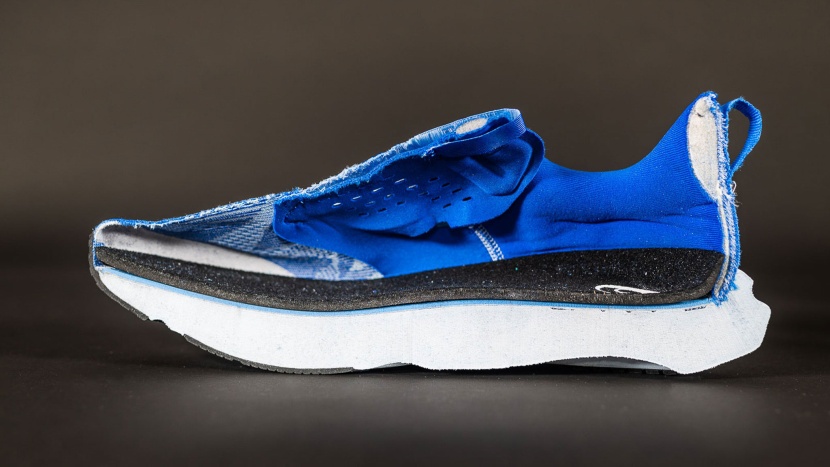
A closer look at our favorite max-cushion shoe (the More v5) compared to our favorite daily trainer (the Novablast). Click the button below to choose any two shoes in our lineup to compare their cushioning directly to one another.
We asked questions like: Do our feet feel protected from the road? How well does the cushioning insulate our legs over longer efforts? Are transitions through our feet during landing smooth or choppy? Do we feel as though we’re “bottoming out” the cushioning? How much compression does the foam have? How much resilience (energy return) does the foam have? How stiff is the shoe?
Cushioning: Daily Trainers
Daily trainers are the workhorses of the running shoe world. They’re designed to get you through the majority of your mileage feeling comfortable, but should still be able to handle most workouts you’ll throw at them. As with all running shoes, daily trainers sit in different places on the comfort vs. performance spectrum. Some we classify as speed trainers, meaning they’re best suited to faster running. Others are more comfort-oriented, providing plush cushioning but less versatility.
One of our favorite all-around shoes, the Asics Novablast 5, straddles the line between daily trainer and max-cushioning. By the numbers, it probably should sit in the max-cushioning category, with 41 mm of foam at the heel. However, it doesn’t run like a max-cushioned shoe and is remarkably versatile. So, we think it’s best considered as a daily trainer. It’s extremely well cushioned, scoring among the highest in the daily trainer category.
The Nike Vomero 18 is in a similar position, offering a higher stack height with excellent all-around comfort. For runners who value cushioning above all else, this is a great daily trainer. Another Nike trainer that sits on the edge of daily trainer and max-cushioning, the Zoom Fly 6, recorded a very high score thanks to a 41 mm stack height of ZoomX foam. Landings in this shoe are soft and bouncy, and have a great level of responsiveness. The Zoom Fly would make a great marathon training shoe.
The Adidas Adizero Evo SL has a slightly firmer feel underfoot, but also becomes more bouncy at higher speeds. While the Rebel’s 30 mm of stack height feels softer and scores higher, we tend to prefer the firmer and more bouncy ride of the Evo at a wider range of paces. It feels better across the pace spectrum than the Rebel does. The Evo also tends to feel better towards the end of a long run, likely due to the 39 mm of stack height and more resilient foam.
The Saucony Endorphin Speed 4 is a high-performing speed trainer. It’s better for uptempo running than other daily trainers, but still has plenty of cushioning for the longest runs. It has a firmer underfoot feel and is stiffer, thanks to its nylon plate.
The Puma Velocity Nitro 3 and Adidas Adizero SL2 are both great compromises that each provides plush cushioning with the ability to hit faster paces. Both shoes ended up with a high rank in our testing thanks to their balanced performances and excellent price points.
The Puma Velocity Nitro 3 provides a plush landing pad with its NITRO foam in the midsole.
Credit: Nathaniel Bailey
Cushioning: Max-Cushioned Trainers
Max-cushioned trainers tend to be best for eating up long mileage at easy paces. However, some of our favorite all-around trainers fall into this category and utilize some technology from top-tier race shoes to provide versatile, high-performing comfort.
The New Balance Fresh Foam X More v5 is an exceptionally comfortable and decently affordable shoe. The big slab of smooth cushioning is excellent for recovery days, but struggles to run faster.
If you want more pace, the Mizuno Neo Vista has a huge stack of foam and a smooth rocker geometry to create one of the most versatile and comfortable rides in our test. We love this shoe as a daily option, and while it feels best at easy paces, you can also use it for threshold workouts.
Close behind is the Asics Superblast 2, which is slightly less cushioned but more oriented towards faster paces. It can eat up the easy miles, but this is also a shoe that could work as a marathon racer for some runners.
When it comes to easy running, the Asics Gel-Nimbus 27 takes a similar approach. A huge chunk of soft foam makes them comfortable and smooth for your recovery runs.
Just look at all that highly-compressible and resilient foam. The Neo Vista is one of the most comfortable and versatile daily trainers in the lineup as a result.
Credit: Nathaniel Bailey
Cushioning: Race Shoes
The super shoes in our lineup have all been designed to get you through a marathon comfortably. That means they all have high levels of cushioning underfoot, and almost all of them are bouncy and soft. They all fall right under the World Athletics limit for race shoes of 40 mm stack height. They utilize highly resilient PEBA-based or similar supercritical foams to provide a performance and comfort benefit. The Asics Metaspeed Sky Paris stands out for its cushioning that feels both bottomless and responsive.
The Metaspeed Sky Paris has excellent, bottomless comfort.
Credit: Nathaniel Bailey
Upper Comfort
When assessing upper comfort, we consider things like upper materials and stiffness, breathability, fit, and lockdown. We note any particular hotspots or rubbing that the shoe causes and test to verify if it is a shoe issue or a product of our socks and lacing. High on our list of priorities is a snug fit that keeps our foot stable and provides confidence through corners and uneven terrain. We want an upper that offers good support and locks down our heel without our toes feeling cramped. The tongue has to wrap our midfoot precisely, and the laces have to hold us snugly without causing pressure or hotspots.
Upper Comfort: Daily Trainers
Knit-uppers tend to be the most comfortable, thanks to their soft material and slightly stretchy fit. They tend to struggle with breathability, though. Two of our favorites in this category are the Novablast 5 and the Adidas Adizero Evo SL.
The Adrenaline GTS 23 also feels snug with excellent lockdown and a gusseted tongue that stays put. When it comes to plush comfort, the Vomero 18 also stands out thanks to its soft materials that feel extremely comfortable when clicking off miles.
The Adizero Evo SL upper is lightweight and breathable, and locks down well for long runs.
Credit: Nathaniel Bailey
Upper Comfort: Max-Cushioned Trainers
Most max-cushioned shoes are geared towards comfort, so the upper tends to feel good. One of our favorite uppers in the entire lineup is in this category — the Mizuno Neo Vista. It utilizes a sock-like knit upper that wraps your foot comfortably and breathes well. The Neo Vista stands out for its execution, and it takes home the highest score for an upper in the lineup.
The sock-like upper of the Mizuno Neo Vista is exceptionally comfortable and has good breathability.
Credit: Natalie Kafader
Upper Comfort: Race Shoes
All the shoes in this category have a lightweight upper, designed to save weight while still providing lockdown. The engineered mesh of the Nike Vaporfly 4 is exceptionally breathable and can be cinched down for great foot security. The Asics Metaspeed Sky heel collar has just enough cushioning to prevent hot spots, while the rest of the upper is slightly stiffer (which adds stability).
The lightweight Vaporfly is exceptionally breathable.
Credit: Nathaniel Bailey
Stability
Here, we’re interested in how stable a shoe feels, both in terms of support during footstrike and laterally on broken terrain. Stability-specific shoes are tricky — we are glad to see an industry shift towards stability shoes that use less medial posting and are more inherently stable neutral trainers. That’s more in keeping with most current peer-reviewed evidence.
You might need support depending on your natural mechanics, but remember that shoes are not a solution to mechanical issues. You should work with a running-focused physical therapist or sports medicine doctor to resolve those mechanical issues rather than self-diagnose your running mechanics and attempt to address them with a shoe.
Stability: Daily Trainers
We love the Saucony Tempus 2 for its non-invasive and enjoyable approach to stability. It is a versatile shoe that we think many runners will get along with. It utilizes an innovative frame of different foam materials to provide a lightweight and comfortable midsole with lots of support.
The Brooks Adrenaline GTS 24 is a decent all-arounder that utilizes a more old-school approach to stability. It uses sidewalls, medial posting, and crash pads to direct your natural movement.
Among daily trainers, shoes that provide a strong lockdown and a wide, low base are often the most stable. The Asics Novablast 5 is a standout in this area. Similarly, the Puma Velocity Nitro and Deviate Nitro provide a strong lockdown and a stable base that performs well on uneven surfaces and hard impacts.
The Tempus 2 uses innovative techniques to provide fun stability.
Credit: Natalie Kafader
Stability: Max-Cushioned Trainers
As a rule of thumb, most max-cushioned shoes aren’t a great stability option. However, the Asics Gel-Kayano 31 provides the best support and stability in the test. It utilizes a wide platform to provide inherent stability and uses geometry rather than uncomfortable medial posting to keep your foot moving forward. It’s also well cushioned, although our testers who land heel-midfoot found the cushioning to be better than those who land mid-forefoot.
The Superblast 2 comes up again in this metric. Sidewalls and a wide platform make this a stable max-cushioned shoe, which is great for runners who want a faster option that has some support.
The wide base of the Kayano provides for great inherent stability without sacrificing comfort.
Stability: Race Shoes
Most racing shoes are pretty unstable. In this test, the Asics Metaspeed Sky isn’t exactly stable, but has a wide base that offers more room for your foot to plant. The Nike Vaporfly offers almost no lateral stability, and is gears almost entirely toward forward motion.
The Metaspeed Sky has a decently wide landing platform – for a racing shoe – and stiffened sidewalls that add somewhat to this shoe’s stability.
Credit: Nathaniel Bailey
Weight
Weight has been proven to be a significant factor in running economy and performance. Weight often differs from the manufacturer listings, and we weigh each size 10.5 per shoe in-house to compare each pair more accurately. There is often a tradeoff with lightweight designs when it comes to overall stability and predicted durability. Many lightweight designs use thinner and lighter upper materials or reduce or eliminate the rubber tread on the outsole. More traditionally designed shoes with padded uppers and durable outsoles are among the heavier designs we tested.
Weight: Daily Trainers
When it comes to daily trainers, the Kinvara 15 takes home top marks. It’s an exceptionally light shoe, which makes it a joy to run fast in.
There’s not much to the Kinvara, which makes it light (and reasonably fast).
Credit: Nathaniel Bailey
Weight: Max-Cushioned Trainers
High stack height often means heavy weight. The More v5 highlights that, taking home some of the lowest scores in this category. However, it doesn’t have to be that way. The Superblast 2 weighs about as much as the average daily trainer, just with far more foam underfoot.
Though thickly cushioned, the Superblast doesn’t weigh as much as its max-cushioning contemporaries.
Credit: Natalie Kafader
Weight: Race Shoes
The lightest shoe we’ve tested is the Nike Vaporfly 4, which is absurdly light and practically disappears on our feet. Weighing less than half an ounce more, the Asics Metaspeed Sky Paris is also insanely light, adding to its responsive feeling and overall race-readiness.
It’s hard to explain just how light the Metaspeed Sky Paris is.
Credit: Nathaniel Bailey
Traction
No one likes sliding around corners or slipping on wet asphalt. We assess each shoe across a range of Montana weather and surfaces, reporting our findings. Honestly, most road shoes will handle typical road-running conditions just fine.
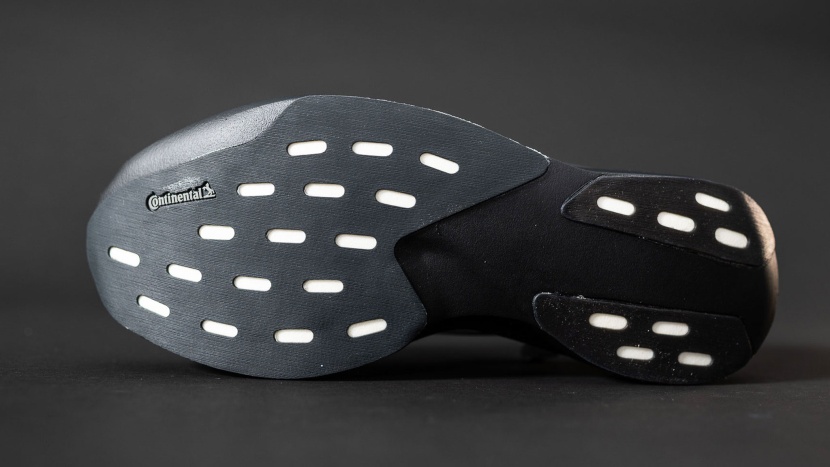
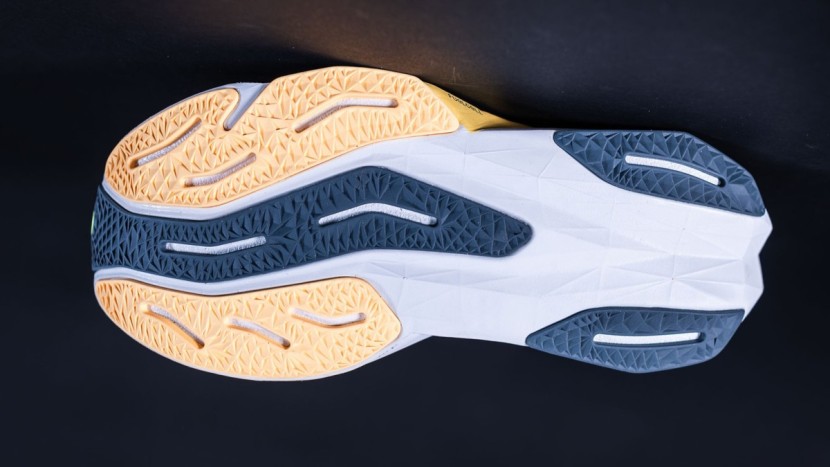
Comparing the lug-less but grippy tread of the Evo SL to the intense tread pattern of the Rebel v4. Click the button below to compare the tread of any two shoes in our current lineup.
However, wet performance can be an issue for some shoes and some rubber compounds. Similarly, the presence and shape of lugs and siping in an outsole significantly alter how confidence-inspiring a shoe is while running fast on loose surfaces.
Traction: Daily Trainers
This one is simple. If you want reliable traction in a range of conditions, regardless of terrain, just get the Puma Velocity Nitro 3 and call it a day. The PumaGrip outsole is the best in our testing, without a doubt. When we’re running through the winter in Montana, it’s the shoe we grab on the nastiest of days.
Our second favorite outsole compound is the Continental rubber found on some Adidas shoes, like the Evo SL, which can really grab well for a shoe with no lugs. New Balance offerings, like the Propel v5, utilize a diamond-shaped outsole tread that we’ve found bites well on wet roads.
The PumaGrip outsole on the Velocity Nitro 3 provides seriously excellent traction.
Credit: Natalie Kafader
Traction: Max-Cushioned Trainers
Most of the max-cushioned shoes in our lineup have average traction levels. The Nike Vomero 18 stands out as having above average grip.
The rubber outsole of the Nike Vomero helps it grip better on wet pavement.
Credit: Natalie Kafader
Traction: Race Shoes
Most race shoes are designed to have solid traction on flat, ideal racing conditions. They tend to cut weight by limiting lugs and traction patterns. Both the Metaspeed Sky and Vaporfly — as well as most other racing shoes we’ve tested — fit this trend.
The tread of a racing shoe like the Metaspeed (shown here) tends to be minimal and may not be enough for wet conditions or gravely corners.
Credit: Natalie Kafader
Responsiveness
In this category, we’re most interested in how a shoe handles different paces. We assess each shoe across a few rough pace categories, including easy running, moderate / marathon pace, threshold paces (between marathon and 10K), and fast (5K or faster).
There are a lot of factors that go into how fast or responsive a shoe feels. Weight is a significant factor, and foam resilience is another. Composite stiffeners (like carbon plates) can benefit some runners, but depend on the type and location of the plate, as well as the specific stride of the runner — the benefits are far from universal. Rocker geometry, or the curve on the bottom of the shoe, changes how a runner rolls through their stride, and can make a shoe feel responsive.
Components of Energy Return
| Intended Use | Energy Return | Midsole | Plate | |
|---|---|---|---|---|
| Asics Metaspeed Sky Paris | Racing | FF Turbo Plus | Carbon | |
| Nike Vaporfly 4 | Racing | ZoomX | Carbon | |
| Adidas Adizero Adios Pro 4 | Racing | Lightstrike Pro | EnergyRods 2.0 | |
| Nike Alphafly 3 | Racing | ZoomX | Carbon | |
| Saucony Endorphin Pro 4 | Racing | PWRRUN PB/PWRRUN HG | Carbon | |
| New Balance FuelCell SuperComp Elite v4 | Racing | FuelCell | Carbon | |
| Saucony Endorphin Speed 4 | Daily Trainer | PWRRUN PB | Nylon | |
| Adidas Adizero Evo SL | Daily Trainer | Lightstrike Pro | ✖ | |
| Asics Superblast 2 | Max-Cushion | FF Turbo Plus, FF Blast Plus | ✖ | |
| Nike Zoom Fly 6 | Daily Trainer | ZoomX | Carbon | |
| Mizuno Neo Vista | Max-Cushion | Enerzy NXT | Full-length plastic | |
| Adidas Adizero SL2 | Daily Trainer | Lightstrike Pro, Lightstrike | ✖ | |
| Puma Deviate Nitro 3 | Daily Trainer | NITROFOAM | Carbon | |
| Saucony Tempus 2 | Stability | PWRRUN/PWRRUN PB | ✖ | |
| Puma Velocity Nitro 3 | Daily Trainer | Profoam | ✖ | |
| Asics Novablast 5 | Daily Trainer | FF Blast Max | ✖ | |
| Brooks Hyperion Max 2 | Daily Trainer | DNA Flash v2 | Full-length plastic |
Responsiveness: Daily Trainers
A good daily trainer should be able to comfortably handle moderate to threshold paces. Daily trainers that err on the side of speed training should thrive at those efforts. No shoe does versatile responsiveness better than the Evo SL. It can smash workouts or easy mileage, and remain very comfortable for both. It does feel a little more energetic at faster paces, and it also encourages you to squeeze the pace when you’re going easy. But it’s easy enough to control, and sets a new standard for pace versatility.
The Saucony Endorphin Speed is another prime example of excellent responsiveness in a daily trainer. It utilizes a nylon plate, rocker geometry, and excellent PWRRUN PB foam to provide an energetic, fast-rolling ride. We found it thrives at threshold pace and can handle fast intervals as well. Compared to the Evo, it has a little more speed at the top-end, and seems to do a little better on extended workouts. However, it’s far less comfortable for long or easy efforts.
The Adidas Adizero SL2 has a premium foam that gives a responsive and resilient ride. It’s great for moderate efforts and longer threshold workouts, though it doesn’t have quite the snap and stiffness of some plated options. If you can accommodate a narrower fit, we highly recommend these daily trainers.
Many daily trainers still have great energy return, making them excellent options for speed training or even some prople’s race day pick.
Responsiveness: Max-Cushioned Trainers
Most max-cushioned shoes simply aren’t responsive. However, the Asics Superblast 2 and Mizuno Neo Vista buck that trend. Both utilize tech from racing shoes (high-end foam or plates) to help provide a more versatile ride. These “super trainers” are the ultimate do-it-all shoes for serious runners. Both are some of our favorite shoes as a result, but they come at high costs that make them less attractive for most runners.
When it comes to more typical max-cushioned shoes, the New Balance Fresh Foam More v5 is our preference for responsiveness. It’s not fast, but the rocker geometry helps keep things rolling a bit more than in other options.
We’ve called the New Balance Fresh Foam More a pillow that rolls well thanks to its rockered geometry.
Credit: Nathaniel Bailey
Responsiveness: Race Shoes
In this category, responsiveness is what matters most. The Metaspeed Sky Paris takes top marks. It’s the fastest shoe we’ve worn, and although the soft foam isn’t ideal for all-out speed at a faster-than-mile pace, we think it makes a solid road mile shoe. The foam is extremely resilient, and the rocker feels natural.
The Metaspeed Sky Paris can rip across a range of distances — though its competitors aren’t far behind.
For short and fast races, we love the Nike Vaporfly 4, which utilizes a lower stack height to provide a nimble and quick feel.
The latest version of the Vaporfly is better suited to sub-marathon distances. Our testers love it for hard track sessions.
Credit: Natalie Kafader
Other Notable Men’s Road Running Shoes
With such a flooded market, there are dozens of pairs of current and previous-version shoes that we’ve tested and are still available for purchase. Here’s a list of a few we’ve tested that didn’t make our cut of the top road running shoes today:
Daily Trainers Worth Considering
- Adidas Adizero Boston 12 — An affordable, well-cushioned, and responsive shoe that feels smooth and lightweight. Swapping a carbon plate for Energyrods 2.0 makes this model versatile without totally demolishing its comfort.
- Asics Gel-Nimbus 27 — With stability at heart, it still has more to offer, with a highly cushioned midsole, an energetic ride, and a very comfortable upper; even if it is a bit heavy and clunky at speed.
- Asics Superblast 2 — A max-cushioned model that doesn’t soak up all your energy into the bouncy sole, this shoe is an exceptionally high-performing, comfortable model — with a matching high price tag.
- Brooks Ghost 16 — This line has a cult following, for its traditional feeling of times before tech took over the industry. With a high heel-toe drop and a comfortable and stable ride, this shoe is a solid choice for heel strikers.
- Brooks Glycerin 22 — This stability-focused shoe is a reliable standby with comfortable cushioning that’s positioned well for heel strikers enjoying runs at slow paces, and seeking additional support and lateral stability.
- Brooks Glycerin Max — Towering underfoot cushion provides a soft landing without feeling mushy, while good balance and a rolling rocker keep things rolling along well enough to be a solid contender as a marathon shoe.
- Hoka Bondi 9 — Thick but firm cushioning and a smooth ride help this chunky shoe cross over into slower-paced runs, though we like it most for long walks and lengthy days on our feet.
- Hoka Clifton 9 — Great cushion and a stable, neutral ride make this shoe easy to like. Its thick stack still maintains a fairly low weight, and we love this shoe most for exploring a new city and spending long days on our feet.
- Mizuno Neo Vista — This super trainer doesn’t skimp on the cushioning, with one of the highest stack heights around. It’s bouncy and comfortable and a blast to run in, remaining a core part of our rotation long after testing was complete.
- New Balance FuelCell Rebel v4 — This plateless shoe still manages to have above-average energy return on top of great underfoot cushioning, feeling as responsive as a plated model but far more comfortable.
- Nike Pegasus 41 — One of the most popular shoes on the market, the Pegasus clusters its cushioning in the heel, helping this shoe to be a solid choice for folks running slower paces with heels hitting the ground first.
- On Cloudsurfer 2 — This version is far more stable than its predecessor, with a wider platform and a firmer foundation. It’s not the most cushioned running option, but can make the crossover from walking or going to the gym in a pinch.
Race Day Competition
- Adidas Adizero Adios Pro 4 — A very propulsive racer with a soft landing, this lightweight shoe falls short when it comes to the stability many runners need.
- Hoka Cielo X1 2.0 — Bouncy and snappy and all the things we want in a race shoe, but without the outside support to prevent over-pronation that can happen for certain runners at high speeds.
- Nike Alphafly 3 — This racer has snappy energy return, low weight, and comfortable, resilient foam. However, it also has the steepest learning curve of any racing shoe and feels particularly unstable cornering at high speeds.
- Saucony Endorphin Pro 4 — A solid intro into supershoes, this pair is snappy, smooth, and fairly stable. Comparatively, it’s not as explosive as other racers, is a bit heavier than we’d like, and runs narrow through the forefoot.
Others We’ve Tested
- Altra Torin 8 — Diehard zero-drop fans who love Altra’s wide toebox design may still enjoy this shoe. But it has a thin sole that lacks the protection or energy return that most runners are looking for.
- Hoka Skyward X — This carbon-plated max-cushion shoe has one of the most comfortable landing platforms, but is shockingly heavy. It’s also extremely expensive, and there are nearly as comfortable shoes you can buy for much less.
- Nike Pegasus Plus — A popular shoe, but with a narrow fit and limited lateral stability. It has a soft landing and a high stack, making it comfortable and fun, but costs more than similar performers.
- Saucony Kinvara 15 — Our women’s team recommends this shoe wholeheartedly, while our men’s team cautions that the thin sole and limited cushioning of this minimalist-adjacent pair aren’t the most comfortable combo.
We tested and compared all the top contenders on the market to help you make the best choice possible for your feet and running style.
Credit: Abriah Wofford
Conclusion
Finding the perfect running shoe isn’t easy (there’s a reason so many runners have a rotation), but after spending hundreds of hours and logging dozens of miles in every pair of shoes in our lineup, we hope we can at least make it easier for you. We hope that this review will help you find the right shoe for your fitness needs and budget, and one that will provide you with an awesome running experience.


